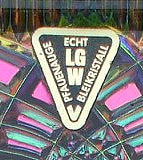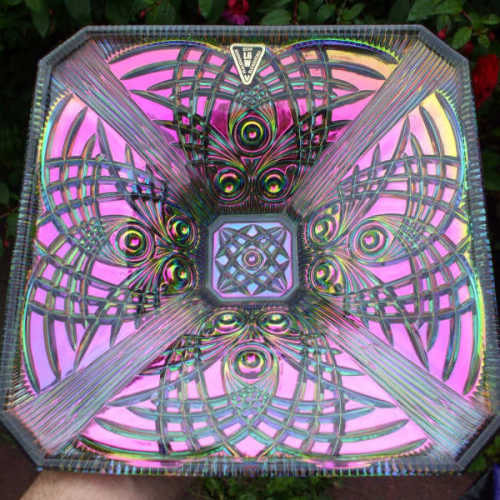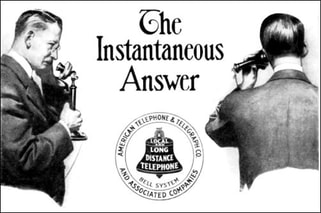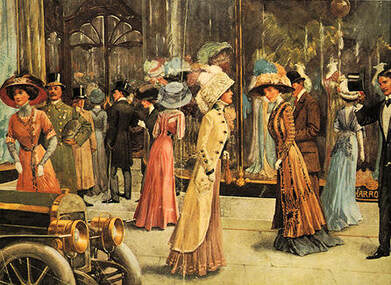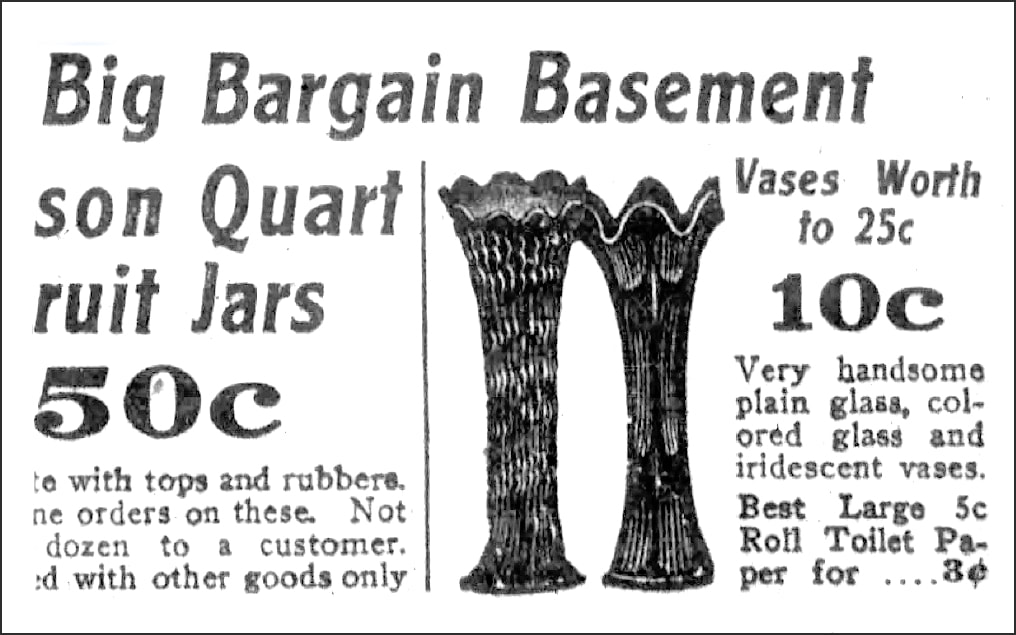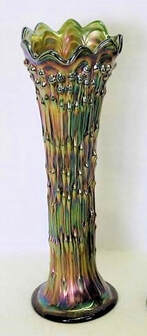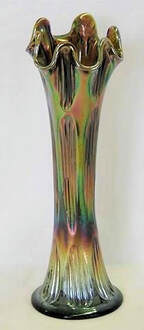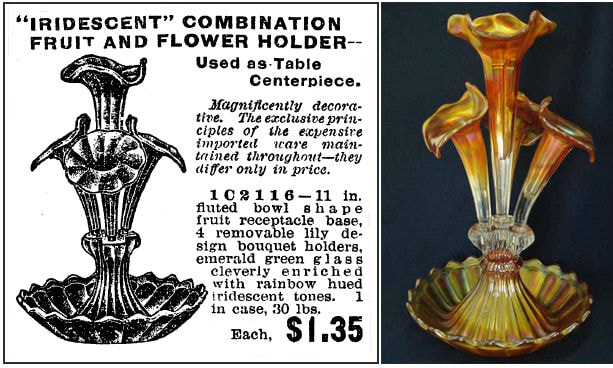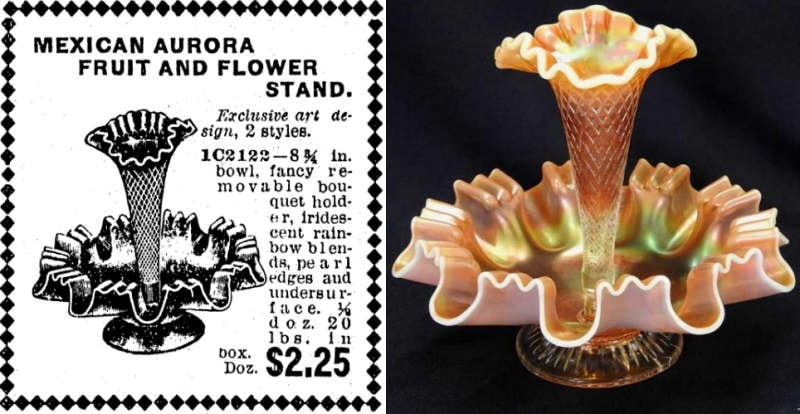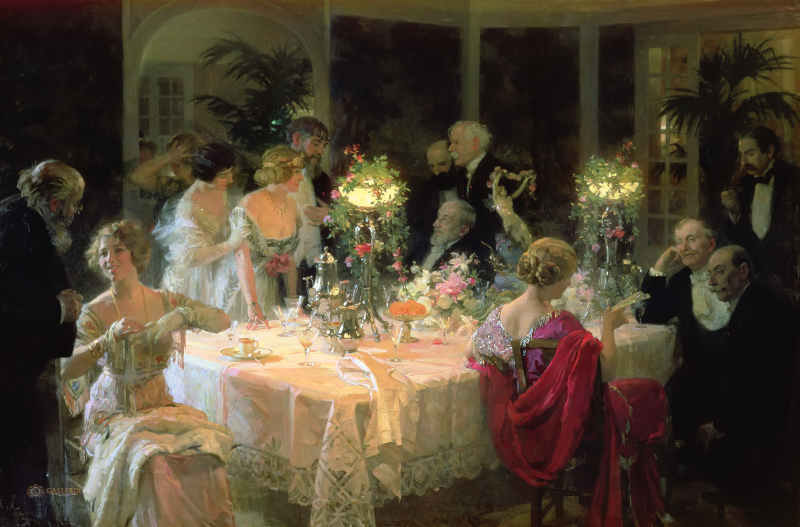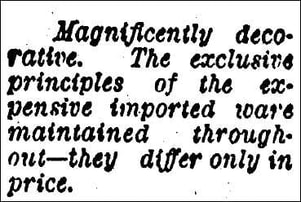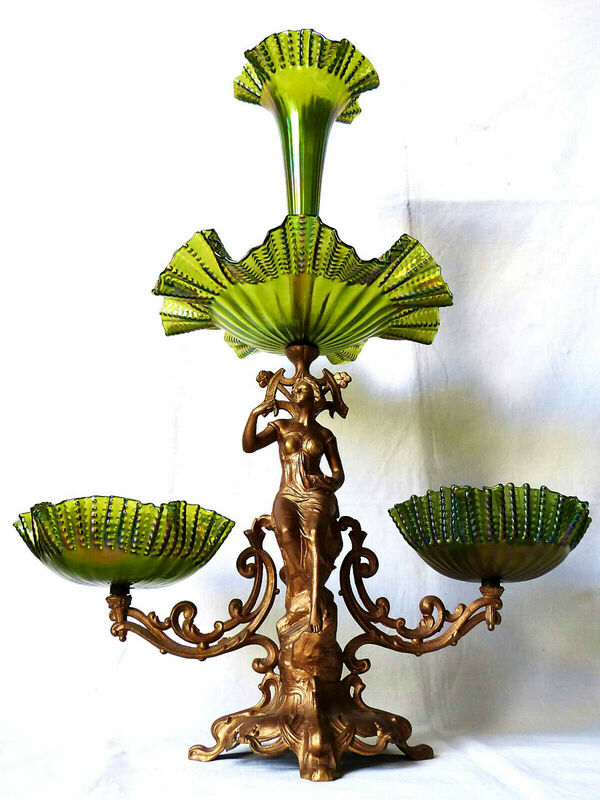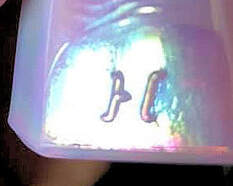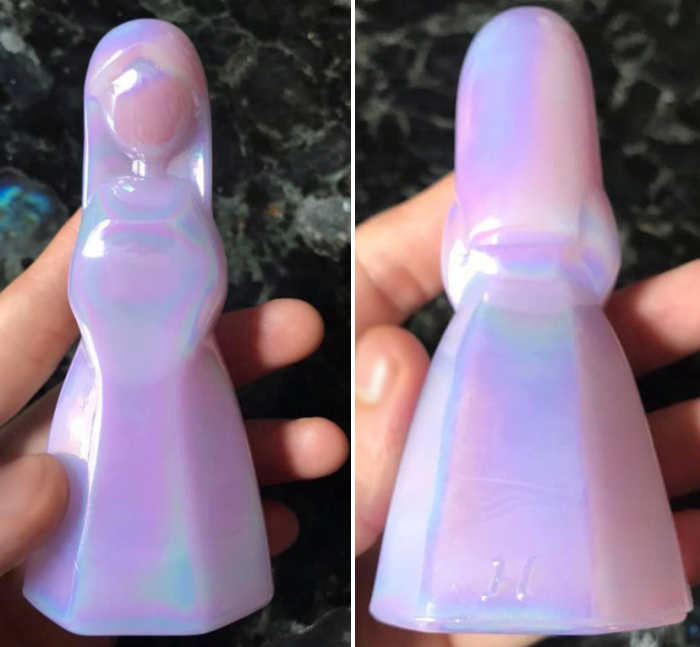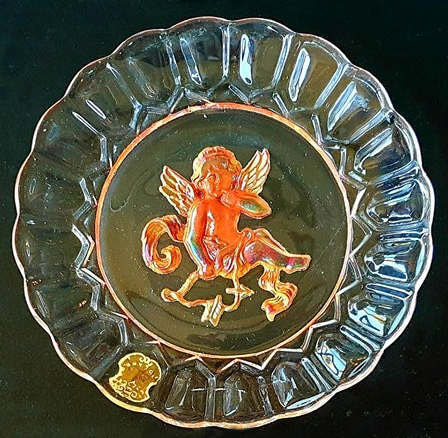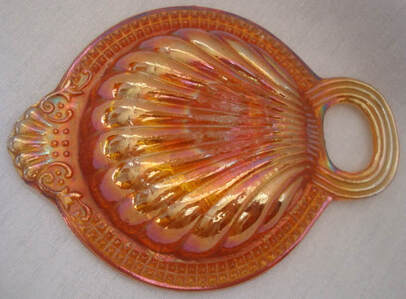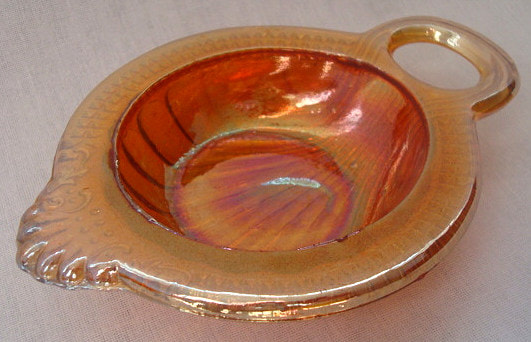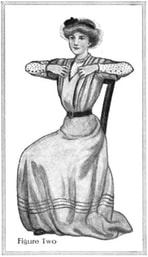NetworK ezine Issue 51. August 2019
Totally Devoted to Carnival Glass
|
What a show-stopper!
This stunning piece was shown by Alan Henderson on our Carnival Glass NetworK Facebook Group in July, and it was an absolute *wow* with everyone. There’s something about the mesmerising design, and those lines that draw the eye right into the centre, that captivates and enthrals. The iridescence is majestic – royal purple and glistening lime. Delicious.
In the centre of the label are the letters LGW – this is the heart of the story. LGW stands for Leinauer Glaswaren, a glass works in Bavaria, where this glass was iridised. Stop there a moment. Please note that we didn’t say it was where the glass was made. The glass bearing the LGW labels was made in many places, including France. But crucially it was subsequently iridised by Leinauer Glaswaren.
The full story about this glass works and its ground-breaking, iridising process was first revealed to the Carnival collecting world in September, 2000, in our original Carnival NetworK journal #27. Credit for the research goes to Siegmar Geiselberger, who helped us to establish the fascinating story behind this amazing glass. In the two decades since we broke this news, many more pieces of LGW iridised glass have been reported. |
Eye of the Peacock. Picture courtesy of Alan Henderson.
|
In a major feature we show you the original article from nineteen years ago, in our Network #27 – we also present a breath-taking gallery of LGW glass for you. Here is the link: Leinauer Glaswaren - LGW
A Snapshot of 1910.
1910, when hats were big but life expectancy was low (just 49 years for a man and 52 for a woman). Social media was not easy to access but on the plus side, exercising wasn’t too strenuous.*
1910, when hats were big but life expectancy was low (just 49 years for a man and 52 for a woman). Social media was not easy to access but on the plus side, exercising wasn’t too strenuous.*
|
Newspapers and journals were the forms of media relied on by most people in 1910, but the telephone was making inroads. This 1910 ad for AT&T promotes the ‘phone for “the instantaneous answer” – a desire in common with most people using today’s social media. |
Image in public domain. Courtesy Wikimedia Commons.
|
Achieving “the instantaneous answer” for ID questions about Carnival Glass is one of the great advantages of our Carnival Glass Network Facebook group. We have active members all around the world so it's fair to say we have complete 24x7 action! Here is the link (it's a "closed" group, so the privacy of your posts is protected within the group): Carnival Glass NetworK.
|
1910, however, was a very good year for Carnival Glass. It was popular and well established (having been introduced a couple of years earlier) and was selling well. The 1910 ad shown here, from the Oregon Daily Journal featured two vases that were being sold in a large store’s Bargain Basement. The November 1910 Butler Brothers wholesale catalogue was called the “Santa Claus Edition”. It was full of gift ideas ... and there was plenty of Carnival Glass! |
Epergnes were popular.
Above, left: Northwood's Wide Panel epergne in marigold, and right, Dugan's Fishnet epergne in peach opal (both pictures courtesy Seeck Auctions).
Both Fenton and Northwood’s Carnival was widely featured in that 1910 catalogue too – in fact Northwood’s Wide Panel epergne was advertised not just once, but twice, in the same catalogue. We also see another epergne in that 1910 Butler Brothers, and another maker - Dugan's Fishnet epergne with "pearl edges", that is peach opal. It has only a single horn, and the bowl has Dugan's characteristic deep 3-in-1 edge.
Both Fenton and Northwood’s Carnival was widely featured in that 1910 catalogue too – in fact Northwood’s Wide Panel epergne was advertised not just once, but twice, in the same catalogue. We also see another epergne in that 1910 Butler Brothers, and another maker - Dugan's Fishnet epergne with "pearl edges", that is peach opal. It has only a single horn, and the bowl has Dugan's characteristic deep 3-in-1 edge.
|
Note the price difference: Dugan's epergne was $2.25 per dozen (12), whereas Northwood's - altogether a more substantial and more "upmarket" offering - was $1.35 each. The epergne was used as a table centrepiece, in the manner described in the Butler Bros ad above. The bowl at the base was intended to be filled with fruit, while the lilies (horns) would hold flowers. It would have looked truly breath-taking on the stylish dinner table, filled in that way. Magnificent adornments on the dining table were very fashionable in the Edwardian era of the early 1900s. Flowers, fruits and more, were shown on the table in “The End of Dinner” by Jules-Alexandre Grun, 1913 (right). Courtesy Wikimedia Commons. In an extensive and fascinating feature, we delve deeper into the Carnival that was on offer in 1910, and we take a look at what was going on at the main US Carnival Glass makers. It’s unmissable! Here is the link: A Snapshot of 1910 |
|
The Emerald Goddess.
The fascinating Butler Brothers ad in the feature above shows a Northwood Wide Panel epergne. The descriptive text is very interesting indeed. The Northwood epergne is compared with “the expensive imported ware” and having the same "exclusive principles" which were lilies for flowers and bowls to hold the fruits – plus of course, it had to have impact, grace and style. And the stunning green epergne on the right, epitomises the “expensive imported ware” referred to in the ad. In itself, this epergne is not only fascinating, but also adds to our knowledge of the development of Carnival Glass making.
The inimitable Stan Hoegerman brought this incredible epergne to our attention in late June, 2019. Its similarity to the well-known Goddess of Athena epergne is undeniable. Stan made contact with the owner and researched this amazing piece for us, and we are honoured to present the subsequent feature on our website, with our thanks to Stan for all his work. There are more amazing photos of this superb item, together with links to our research pages on the Four Flowers Variant and its likely origins at Brockwitz. You can read it all here: Emerald Goddess. |
This magnificent epergne is a perfect example of “the expensive imported ware”. Picture courtesy Mike Krüger, Art & Antiques in the Bauhaus city of Dessau, Germany.
|
|
Please Meet Jenny!
In early June, Joey Aronhalt posted an intriguing photo on our Carnival Glass NetworK Facebook Group, explaining how he found this delightful item in a thrift store, and that it has a maker’s mark. We discovered the answer to the maker’s mark puzzle, and the story of this delightful item, in the March, 1998 edition of the Collectible Carnival Glass Association newsletter. The author of the article was Wilma Thurston and she explained that this figurine was called “Jenny”.
|
A Golden Cupid Find.
|
Grateful thanks to Gio Sabino Lopez for allowing us to feature his amazing find of a Golden Cupid plate that was recently reported in our Carnival Glass NetworK Group on Facebook! It is approx. 6 inches (14 cm) wide and it has the original paper label for Zabkowice (Beverly Crystal was the name they sold under in Australia) that clearly shows the word Poland. This is the first plate that has been reported in the Golden Cupid pattern – only berry bowls have previously been known. The master bowl that accompanies this set is the Diana the Huntress. The hunt is now on for a large chop plate in that pattern in Carnival. We have a feature article showing all the known (to date) "Golden" patterns and here is the link: Golden Treasures. Golden Cupid small plate courtesy of Gio Sabino Lopez. |
|
Bahia Shell.
Just in, from Brazil, glass researcher Claudio Deveikis reports a set of six dessert bowls shaped like shells. The underneath (shown below, left) has the most beautiful encircling design. These exquisite bowls were almost certainly made in Brazil. Claudio explains that the name he has chosen is for the beautiful Brazilian, coastal state of Bahia. More on this beautiful piece in the next issue of your NetworK ezine. |
Bahia Shell, pictures courtesy of Claudio Deveikis.
|
* Smile! A look back to 1910, from the Ladies Home Journal. This is Exercise Six from an article entitled “Dr. Bentley’s Physical Culture for Girls.” Sitting correctly with body uplifted, exhale. Then, while exhaling, tap the chest as in Figure Two. After the lungs have been filled to their capacity hold the breath and continue the tapping as long as is comfortable. Repeat five times a day. |
Privacy and the use of your information: we only use your name and email address to send you your FREE Carnival Glass NetworK ezine. We will not share your name or email address with anyone else, or use it for any other purpose. You can change your mind about receiving your NetworK ezine at any time by clicking the unsubscribe link at the foot of every issue, or by emailing us at [email protected]
Join us on Facebook
We invite you and your friends to join us all on NetworK's fast growing and very active Facebook Group (link is below), and if you have missed any of the previous issues of NetworK and NetworK Specials, they are all here: Back Issues.
We invite you and your friends to join us all on NetworK's fast growing and very active Facebook Group (link is below), and if you have missed any of the previous issues of NetworK and NetworK Specials, they are all here: Back Issues.

